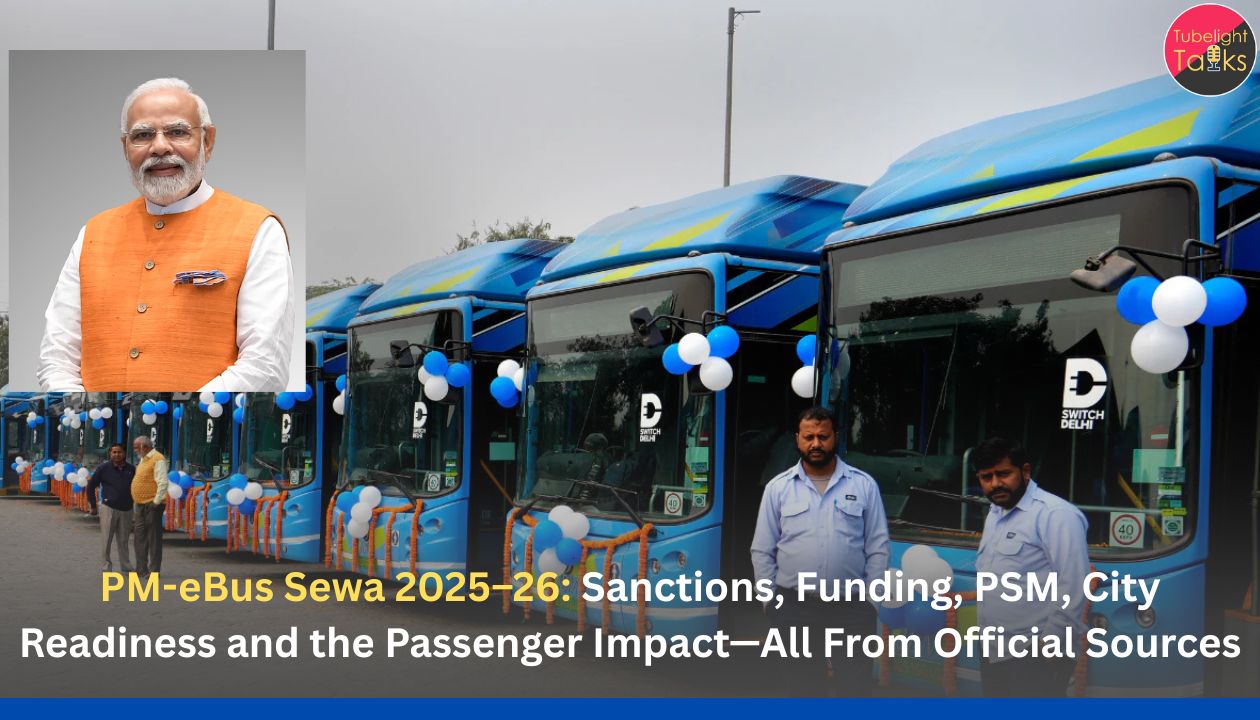PM e-Bus Sewa: India’s PM-eBus Sewa is moving from paperwork to buses on the road. As of 2025, 7,293 electric buses stand sanctioned across 14 States and 4 UTs, backed by per-km Central Assistance and 100% support for behind-the-meter power infrastructure. A brand-new official website has launched to track LOA/LoCQ, funds and city progress, while Payment Security Mechanism (PSM) guidance puts escrow and direct-debit discipline at the heart of operator payments.
This explainer compiles everything cities, depots, operators and commuters need—per-km rates, eligible cities, depot norms, tenders, and latest UMI 2025 updates—strictly from MoHUA/PIB/MHI/CESL.
What’s officially sanctioned—and where we are now
The Government’s status note confirms 7,293 e-buses sanctioned to 14 States and 4 UTs, with nearly ₹1,000+ crore sanctioned for associated power and depot works. Disbursals have started, and the note reiterates that deployment depends on depot readiness and tender conditions.
At a broader EV ecosystem briefing (Aug 2025), the Ministry specified per-km Central Assistance (CA) slabs (₹24/₹22/₹20 for standard/midi/mini) and shared the state-wise bus counts (e.g., Maharashtra 1,559, Karnataka 750, Andhra Pradesh 750, Rajasthan 675, Madhya Pradesh 582, Gujarat 450, Haryana 450, etc.). It also recorded funds sanctioned and released for depot and power projects. Editors reporting numbers should cite this page or the new website dashboard.
New in November 2025: At the Urban Mobility India (UMI) 2025 valedictory, the logo and the official PM-eBus Sewa website were launched, consolidating scheme information, dashboards and city updates in one place.
The scheme proposals & board notes
Purpose and scope
PM-eBus Sewa supports 10,000 e-buses via a PPP model (GCC/wet lease) with per-km CA for 10 years (or up to March 2037). It prioritises cities without strong bus services, and complements buses with Green Urban Mobility Initiatives: NCMC-based AFCS, ITMS, bus priority and last-mile integration.
Who is eligible?
Per official guidance, cities with population between 3–40 lakh, plus State/UT capitals below 3 lakh, can participate. Central Assistance is on a per-km basis; 100% CA for behind-the-meter power; and 60–100% for depot civil works depending on city category.
The new website at a glance
The PM-eBus Sewa portal lists guidelines, CSSC minutes, participating cities, tenders, publications, and a dashboard. A ticker highlights LoCQ issued for 5,918 buses and LoA for 4,107 buses across 61 cities, plus milestones like Escrow/DDM acknowledgements in states. It also reiterates ₹24/km support for standard buses and 100% support for power infra.
Money flows: CA rates, escrow & the Payment Security Mechanism (PSM)
Per-km support and city share
CA slabs: ₹24 (12-m standard), ₹22 (9-m midi), ₹20 (7-m mini); escalation up to 5%/year allowed as per guidelines. City/state bears resource gaps beyond CA, fares and non-fare revenue.
Escrow & PSM essentials
Guidelines require a dedicated escrow account, with 3 months of CA deposited in advance, replenished quarterly, and fixed-date payouts to the operator—reducing arrears risk. The PSM is formalised by the Ministry of Heavy Industries, with gazetteed scheme documents and SOPs (2024–25) now public. Cities must provide a state guarantee and accept the PSM and Direct Debit Mandate (DDM) discipline.
“CA is paid per km for 10 years, with escrow-based payouts and state guarantees; 100% CA for behind-the-meter power infra and 60–100% for depot civil works per category.”
How tenders run: CESL aggregation, LoA & LoCQ
CESL executes all-India demand aggregation on a GCC wet-lease model, issuing tenders and Letters of Award (LoA) and Letters of Confirmed Quantity (LoCQ). Procurement listings and monthly summaries show operators and lots being finalised—your city’s LoA/LoCQ status now appears on the portal.
Why LoA vs LoCQ matters
- LoCQ locks quantities post-discovery.
- LoA advances to contract award stages across cities.
Both hinge on city readiness—escrow in place, PSM accepted, depot/power works moving—so LOA/LoCQ without on-ground readiness can delay actual bus induction. The website ticker shows consolidated counts to date.
Depot, chargers & power: what must be ready before buses arrive
Power & civil works
The guidelines provide 100% CA for behind-the-meter power infra (substations etc.; charger & cable from meter to charger excluded) and category-based CA for depot civil (up to March 2027). Cities must ensure power capacity before operations and complete civil/electrical works ahead of induction. Normative costs help DPRs, and model DPR templates are to be hosted on MoHUA’s portal.
ESCROW & DDM checklist for commissioners
Set up escrow, secure RBI DDM acknowledgement, and sign concession & escrow agreements. The portal ticker already flags examples (e.g., Karnataka/Gujarat/Rajasthan DDM acknowledgements; Nagpur escrow signed).
A note on city communications
Recent state/city stories (e.g., Haryana) illustrate why depots, charging stations and route plans must be communicated early to avoid public confusion and to fast-track commissioning post-litigation or tender disputes. Use these as practical lessons, but anchor your policy claims to PIB/MoHUA/CESL.
City categories & how many buses you might get
The Challenge Method and population bands cap per-city allocations and set CA rates. As a quick feel, 20–40 lakh population cities can get up to 150 buses; 10–20 lakh and 5–10 lakh bands are at 100, and <5 lakh at 50, subject to scoring and resource gaps. Annexure-2 lists 169 eligible cities.
The passenger experience: what changes for commuters
With NCMC/AFCS and ITMS anchored in the guidelines, cities are expected to deliver tap-in ticketing, real-time ETAs, and priority lanes where feasible. Quiet, zero-tailpipe buses improve air quality and ride comfort, especially on dense corridors serving work trips and schools. The scheme’s intro emphasises job creation and cleaner, more efficient transport—use this when framing city outreach.
Environmental & industrial impact
E-buses lower particulate and NOx along urban arterials, while the Phased Manufacturing Programme under PM E-DRIVE nudges localisation of EV components; although a separate scheme, its alignment with public e-bus deployment is often cited by Ministries to show ecosystem strengthening (suppliers, spares, service). Cite this context carefully from MHI notes.
Intelligence with Duty: the values that keep buses on time
A clean bus and a smart card won’t keep a city moving if we cut corners on the basics—honest contracts, on-time wages, careful safety checks, and truthful reporting when faults occur. These habits of duty and fairness build public trust and make high-tech projects durable. Spiritual guidance that emphasises honest work, non-exploitation and responsibility can actually steady complex operations—whether at a depot or in a control room.
For a simple, practical lens on these values, explore the book “Way of Living (Jeene Ki Raah)” and short discourses (available free) that stress fairness in workplaces and daily conduct.
FAQs: PM e-Bus Sewa
Q1. How many e-buses are sanctioned right now?
7,293 e-buses across 14 States and 4 UTs. Funds for depot and power works have been sanctioned and partly released.
Q2. What per-km support is available?
₹24/₹22/₹20 per km for standard/midi/mini buses respectively, with up to 5% annual escalation per guidelines.
Q3. What about depots and charging infrastructure?
100% CA for behind-the-meter power infra; 60–100% CA for depot civil depending on city category—both with deadlines and norms detailed in guidelines.
Q4. What ensures operators are paid on time?
The Payment Security Mechanism (PSM) + escrow with 3 months’ CA prefunded and fixed-date payouts, plus state guarantees and DDM discipline.
Q5. Where can I see LoA/LoCQ status and city lists?
On the PM-eBus Sewa website, which also hosts guidelines, FAQs and media updates.
Q6. What changed at UMI 2025?
The scheme logo and the official website were launched at the UMI 2025 valedictory, alongside awards and future directions.










